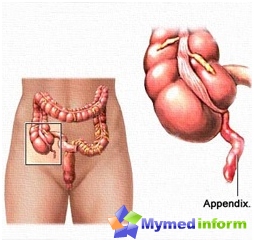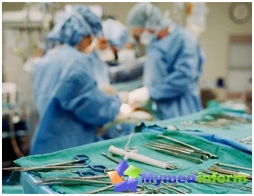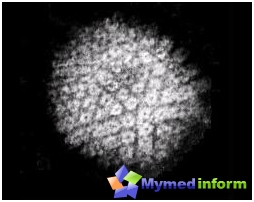
Stomach hives... Doctors advise us to never treat abdominal pain yourself, threatening us with the terrible consequences of self-medication. Let's find out what the symptoms of the most popular surgical disease - appendicitis.
Appendicitis refer to the inflammation of a worm-shaped process of a blind intestine - Appendix. Inflammation causes globular microbes that fall into appendix with blood flow or lymph. The cause of the disease can also serve as undigested residues of food, blocking the lumen of a worm-like process. Depending on the stage of appendicitis, the appendicitis is divided into catarrhal (simple), phlegmonous and gangrenous.
Symptoms of Disease
The signal began to start the disease. Initially, the pain does not have a clear location - the patient seems that the whole belly hurts. But it takes 5-6 hours, and the pain is concentrated in the right iliac region. Our site would like to draw your attention to the next nuance: Appendix is located in different ways, such is the features of the body structure, and the location of pain depends on its position. If the position of the outflow is normal - hurts in the right iliac region, if the process is located high, it hurts on the right almost under the edges if the appendix bent back, the patient feels pain in the lower back area, and if the process is lowered down, hurts in the pelvic area and above the pub.
In addition to painful pain, vomiting may be disturbed, sometimes diarrhea - if the informed process causes a liquid accumulation in the intestine. Language is often covered with a white bloom. The position of the body is forced, since the patient is looking for the least painful position: most often some relief is felt, lying on the right side or on the back. Any spontaneous muscle tension - laughter, cough - sharply enhance pain. If you know a little anatomy, you can try carefully (!!!) Take a patient's belly: in the right bottom of the abdomen they will noticeably tense muscles, and the patient will feel pain during palpation. At this stage, it is necessary to urgently cause ambulance and hospitalize the patient.
The development of appendicitis

The doctor will determine the form of appendicitis - simple appendicitis is characterized by an inflamed duct-like procession. The body temperature is slightly elevated, usually not more than 37.5.
If the pain is not very strong, nausea and vomiting no (it happens often) the patient is not in a hurry to consult a doctor. And then the simple appendicitis goes into a phlegmosis form. The wormless process itself is filled with pus, ulcers arise on its surface. Because of the ulcers, the inflammation begins to spread on the fabric surrounding the process - the walls of the intestine, peritoneum. At this stage, the patient is disturbed by pain, increasing at the tension of the abdominal muscles, in thin people the inflamed process can even be forgiven, it will resemble a dense roller.
In the worst cases, phlegmous appendicitis goes into a gangrenous form. In this stage, the process filled with pus processes inflammation on the whole abdominal cavity. However, patients notice that those who worried their pain passed - this is due to the fact that the nerve cells of the inflamed dwarf-shaped process died. In the place of pain comes the deterioration of the general condition. After all, the entire abdominal cavity is drawn into the inflammatory process. Incitization of the body is rapidly growing, the patient feels a strange euphoria, the pulse holds at 100 strikes per minute (normally 65-70), the skin is pale, it is difficult to move, the belly will go.
If the patient was not assisted, the inflamed appendix breaks through - this moment is very painful for the patient, the pus is poured on the abdominal cavity and the life of the patient is threatened due to total blood infection. Our site tells you all these horrors to convince you how quickly you will seek medical help if you are bothering abdominal pain.
Diagnosis of appendicitis

Appendicitis is quite difficult to determine - symptoms change depending on the location of the process, and the doctor is deprived of the possibility «look in» to the patient in the belly. Traditionally appendicitis is diagnosed, based on blood tests and urine tests - the amount of white blood cells increases in the blood, and protein appears in the urine. But this is not limited to the diagnosis of appendicitis.
X-ray in appendicitis make rarely - it is more characteristic of children. On the x-ray you can only reveal a wheelchained stone, blocking the hole of the draft-shaped process. To determine acute appendicitis use ultrasound. If the cause of pain is not in the appendix, the process is practically not visible on the ultrasound, and if it is inflamed, the process will be visible, like a tube with a diameter of about 7 mm, and around it the doctor will see the fluid accumulation around it.
Another type of diagnostics - computed tomography. CT also gives an image of an enlarged process, also visible altered intestinal fabrics and peritoneum.
See the inflamed appendix in the middle of the laparoscopy. In the abdominal wall, a small incision is made in which a fiber optic tube is introduced with a video camera at the end. This is the most reliable diagnostic method.
Treatment of appendicitis

If the patient enters the hospital, suffering from pain, no one will drag him at once on the operating table. This is due to the fact that many other diseases may be masked under the symptoms of appendicitis, for example, inflammatory processes in the kidneys, in women - inflammation of the genital organs. Therefore, doctors will disappear for some time for the development of the disease, collect the tests and only then make a conclusion about the need for operational intervention. If diagnosed is diagnosed «acute appendicitis», Treatment will be operational. Operation to remove appendix is carried out in two ways: traditionally and endoscopically.
With a traditional operation on an inflamed process, a cut is made to a length of 8-10 cm. The surgeon cuts the muscles, inspects the process, and if the cloth surrounding it is not inflamed, the appendix is removed, and the hole in the intestine at the point of attachment of the appendix is sewn.
With an endoscopic operation in the patient's belly, a thin tube with a camera is injected. The doctor sees the image on the monitor. Tools are administered through special holes and remove the process under constant visual control. With endoscopic operation, cuts are very small, the postoperative period is much easier and faster. Modern surgery is so good that the patient with a non-complicated appendicitis is discharged the day after the operation. If the process has nevertheless ripped and started peritonitis, it will have to be a story in the hospital for about a week. These days the patient will be intravenously to receive antibiotics, which will help the body to deal with the development of infection. When the patient only enrolled in the hospital with suspicion of appendicitis, the doctor will immediately appoint him antibiotics (Cefazoline, Cefantrall, Erythromycin and others) - this is necessary to prevent the development of infection after surgery.
Our site would like to clarify for everyone else and such a moment. What happens if the patient got on the operating table, the doctor made a cut and found that the appendix is not inflamed? The doctor most likely will still remove the worm-shaped process to prevent the development of appendicitis in the future.
No special diet after the removal of appendix is usually not required.
Chronic appendicitis
It happens that the human body has so powerful immunity, which is capable of suppressing the inflammation of the appendix. However, when weakening immunity or when the load on the muscles of the abdomen is inflammation again «Rises his head». This is the so-called chronic appendicitis - a person periodically arises in the right of the right iliac region. Chronic appendicitis delivers a patient with a lot of inconvenience: every attack of appendicitis threatens the development of peritonitis, and with each attack you need to contact the doctor. Chronic appendicitis does not require removal of the process, however, if the attacks are repeated often, the process is better removed.
Show care of your health and do not neglect medical care for any pain and ailments. Timely appeal to the doctor will help to avoid many unwanted consequences.









